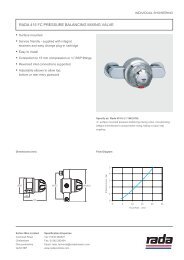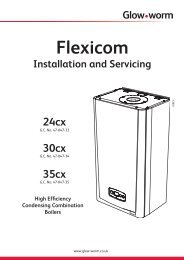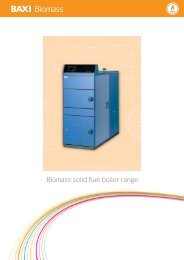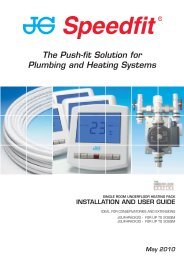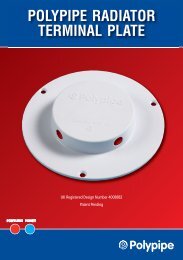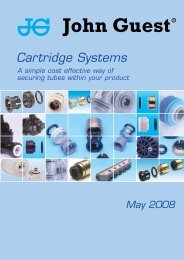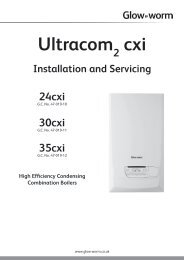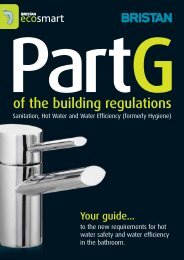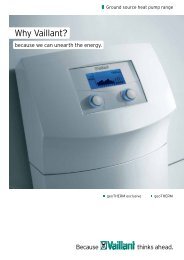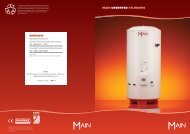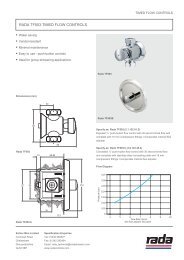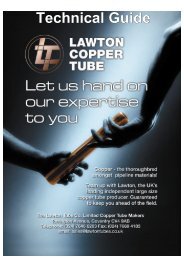Hep20 Technical Handbook
Hep20 Technical Handbook
Hep20 Technical Handbook
Create successful ePaper yourself
Turn your PDF publications into a flip-book with our unique Google optimized e-Paper software.
Hep 2<br />
O ® Design Considerations<br />
Systems Planning<br />
Temperatures and<br />
Pressures<br />
This section covers the maximum<br />
temperatures and pressures<br />
associated with hot, cold and central<br />
heating systems.<br />
Table 10 relates to plumbing and<br />
heating systems generally and shows<br />
the type of service, the temperature<br />
at which it operates and the<br />
pressure usually assoiciated with<br />
these.<br />
Cold water systems<br />
The normal working pressure for<br />
cold water systems is 3 to 4 bar<br />
although in some areas this may rise<br />
to 7 bar during the night.<br />
Hot water systems<br />
These are usually tank fed with a<br />
maximum of 1 bar. Unvented<br />
systems operate at about 2 to 2.5<br />
bar. A safety device prevents the<br />
system operating over 3 bar or<br />
100ºC. The maximum safe<br />
temperature is 60ºC.<br />
Combination boilers operate<br />
between 1 and 1.5 bar only: a safety<br />
device prevents the boiler operating<br />
above 3 bar.<br />
Note that 1 bar = 14.5 pounds per<br />
square inch = 100,000 Pascals = 10<br />
metres of static head.<br />
Recommended service<br />
temperatures and pressures for<br />
Hep 2 O ® pipework<br />
Hep 2 O ® has a minimum design life<br />
expectancy of 50 years provided the<br />
system is installed in accordance with<br />
the manufacturer’s recommendations.<br />
These recommendations include<br />
service temperatures and pressures.<br />
Service temperatures are defined as<br />
the maximum temperature that can<br />
occur during normal operation.<br />
The malfunction temperature is<br />
defined as the maximum<br />
temperature applied to the system<br />
in the event of control thermostat<br />
failure or malfunction. The system<br />
could remain intact at this<br />
temperature and pressure for 3 to 4<br />
months.<br />
Table 11 shows the recommended<br />
service temperatures and pressures.<br />
Table 10 Maximum Temperatures and Pressures<br />
Flow rates<br />
Although the bore of Hep 2 O ® pipe<br />
is less than its copper equivalent<br />
actual system flow rates are not<br />
significantly lower. This is due to<br />
four reasons:<br />
•<br />
the system requires fewer fittings,<br />
i.e. elbows - a 15mm copper<br />
elbow reduces the flow of a<br />
system by being equivalent to<br />
adding 0.5m to the pipe run.<br />
•<br />
the smooth bore does not allow<br />
corrosion or scale to build up<br />
and reduce the flow of a system.<br />
•<br />
the method of cutting and<br />
jointing ensures there are no<br />
burrs or protrusions of solder to<br />
impede the rate of flow.<br />
•<br />
by using the flexibility of the pipe<br />
the course of the water takes<br />
fewer sharp bends and the flow is<br />
impeded less.<br />
Service Temperature Pressure<br />
Cold water 10ºC to 20ºC up to 7 bar<br />
Hot water up to 60ºC 1 bar for vented systems<br />
3 bar for unvented systems<br />
Central heating 82ºC 1 bar for vented systems<br />
3 bar for pressurised and combination<br />
systems<br />
Table 11 Recommended Service Temperatures and Pressures<br />
Temperature (ºC) 20 30 40 50 60 70 80 90 114<br />
Pressure (Bar) 12.0 11.5 11.0 10.5 9.0 8.0 7.0 6.0 3.0<br />
Note that 114ºC = malfunction<br />
58



